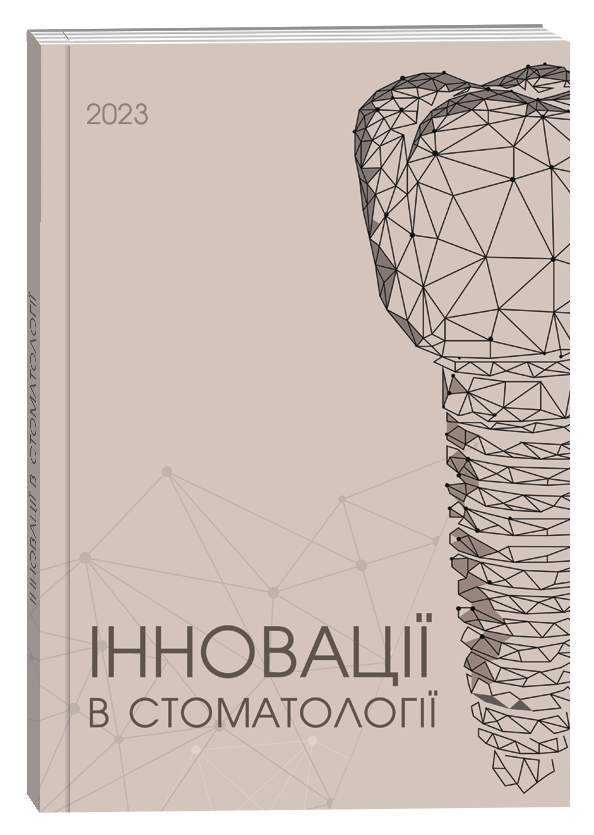СТРЕС І ДИСФУНКЦІЙНО- БОЛЬОВІ РОЗЛАДИ СКРОНЕВО-НИЖНЬОЩЕЛЕПНОГО СУГЛОБУ У ЖІНОК (ОГЛЯД ЛІТЕРАТУРИ)
DOI:
https://doi.org/10.35220/2523-420X/2025.1.24Ключові слова:
дисфункційно-больові розлади скронево-нижньощелепного суглобу, жіночі статеві гормони, стрес, жувальна дисфункціїАнотація
Вступ. Відомості про роль жіночих статевих гормонів в етіології захворювань суглобів в літературі суперечливі. Деякі дослідження показали, що естроген необхідний для неушкодженої структури СНЩС. Жінки із дисфункційно-больовими розладами скронево-нижньощелепного суглобу (TMD) демонструють широкий спектр поведінкових і психосоціальних симптомів, включаючи підвищений стрес, тривогу, смуток і соматизацію. Бали деяких особистісних рис синдрому TMD, таких як істерія та депресія, були лише трохи нижчими порівняно з показниками пацієнтів з психічними розладами, і навіть тяжкість соматичних симптомів-жінок із TMD була вищою порівняно з пацієнтами з психічними розладами, що свідчить про те, що їх психологічний статус був подібним до пацієнтів із психічними розладами. Мета. На підставі аналізу літературних джерел визначити взаємозвꞌязок психосоціальних симптомів із дисфункційно-больовими розладами скроневонижньощелепного суглобу у жінок. Дослідження, наведені в статті мали на меті порівняння інтенсивності болю, варіабельністю серцевого ритму (ВСР), психологічні фактори та рівень кортизолу в слині у пацієнтів TMD та виявили, що інтенсивність болю та психологічний дистрес у групі TMD були значно вищими, а інтенсивність болю показала позитивну кореляцію з психологічним стресом. Матеріали і методи. Інформаційний пошук та аналіз наукових джерел проведено із використанням наукометричних баз Web of Science, PubMed, Google Scholar за останні 10 років. Висновок.Врахування психологічних факторів, включаючи стрес, є необхідним під час обстеження жінок із захворюваннями СНЩС, а лікування TMD має бути мультидисциплінарним із залученням відповідних фахівців.
Посилання
Abdrabuh, Abrar Baljon, & Kamilya Alyami, Yagoub. (2020). Impact of Estrogen Therapy on Temporomandibular Joints of Rats: Histological and Hormone Analytical Study. The Saudi Dental Journal. 33. DOI: 10.1016/j.sdentj.2020.07.006
Farzin, M., Taghva, M., & Babooie, M. (2018). Comparison of temporomandibular disorders between menopausal and non-menopausal women. J Korean Assoc Oral Maxillofac Surg., 44(5), 232–236. doi: 10.5125/ jkaoms.2018.44.5.232
Robinson, J. L., Soria, P., Xu, M., Vrana, M., Luchetti, J., Lu, H. H., Chen, J., & Wadhwa, S. (2018). Estrogen Promotes Mandibular Condylar Fibrocartilage Chondrogenesis and Inhibits Degeneration via Estrogen Receptor Alpha in Female Mice. Sci Rep., 8(1), 8527. doi: 10.1038/s41598-018-26937-w
Emmanuelle, N. E., Marie-Cécile, V., Florence, T., Jean-François, A., Françoise, L., Coralie, F., & Alexia, V. (2021). Critical Role of Estrogens on Bone Homeostasis in Both Male and Female: From Physiology to Medical Implications. Int J Mol Sci, 22(4), 1568. doi: 10.3390/ ijms22041568
Valdes, A., & Bajaj, T. (2023). Estrogen Therapy. In: StatPearls [Internet]. Treasure Island (FL).
Chen, P., Li, B., & Ou-Yang, L. (2022). Role of estrogen receptors in health and disease. Front Endocrinol (Lausanne), 13, 839005. doi: 10.3389/fendo.2022.839005
(2022). The 2022 Hormone Therapy Position Statement of The North American Menopause Society” Advisory Panel. The 2022 hormone therapy position statement of The North American Menopause Society. Menopause, 29(7), 767-794. doi: 10.1097/ GME.0000000000002028
De Franciscis, P., Colacurci. N., Riemma, G., Conte, A., Pittana, E., Guida, M., & Schiattarella, A. (2019). A Nutraceutical Approach to Menopausal Complaints. Medicina (Kaunas), 55(9), 544. doi: 10.3390/ medicina55090544
Amirkashani, D., Rohani, F., Khodadost, M., Hoseini, R., Alidoost, H., & Madani, S. (2022). Estrogen replacement therapy: effects of starting age on final height of girls with chronic kidney disease and short stature. BMC Pediatr., 22(1), 355. doi: 10.1186/s12887-022-03406-y
Ivković, N., Racic, M., Lecic, R., Bozovic, D., & Kulic, M. (2018). Relationship Between Symptoms of Temporomandibular Disorders and Estrogen Levels in Women With Different Menstrual Status. J Oral Facial Pain Headache, 32(2), 151–158. doi: 10.11607/ofph.1906
Jie, Liu, Raouf, & A. Khalil (2017). Chapter Ten – Matrix Metalloproteinase Inhibitors as Investigational and Therapeutic Tools in Unrestrained Tissue Remodeling and Pathological Disorders,Editor(s): Raouf A. Khalil, Progress in Molecular Biology and Translational Science,Academic Press, 148, 355-420, ISSN 1877–1173, ISBN 780128127766, doi: 10.1016/bs.pmbts.2017.04.003
Shah, N. M., Lai, PF., Imami, N., & Johnson, M. R. (2019). Progesterone-Related Immune Modulation of Pregnancy and Labor. Front Endocrinol (Lausanne), 10, 198. doi: 10.3389/fendo.2019.00198
Hasmet Yazici, Mine Islimye Taskin, Gurhan Guney, Adnan Adil Hismiogullari, Erhan Arslan, & Kamil Gokce Tulaci. (2021). The novel relationship between polycystic ovary syndrome and temporomandibular joint disorders,Journal of Stomatology, Oral and Maxillofacial Surgery, 122(6), 544–548, ISSN 2468-7855, doi: 10.1016/ j.jormas.2020.10.008
Berger, M., Szalewski, L., Bakalczuk, M., Bakalczuk, G., Bakalczuk, S., & Szkutnik, J. (2015). Association between estrogen levels and temporomandibular disorders: a systematic literature review. Menopause Review/Przegląd Menopauzalny, 14(4), 260–270.
Sun, L. H., Zhang, W. X., Xu, Q., Wu, H., Jiao, C. C., & Chen, X. Z. (2019). Estrogen modulation of visceral pain. J Zhejiang Univ Sci B, 20(8), 628–636. doi: 10.1631/ jzus.B1800582
Bueno, C. H., Pereira, D. D., Pattussi, M. P., Grossi, P. K., & Grossi, M. L. (2018). Gender differences in temporomandibular disorders in adult populational studies: a systematic review and meta-analysis. Journal of oral rehabilitation, 45(9), 720–729.
Bi, R. Y., Zhang, X. Y., Zhang, P., Ding, Y., & Gan, Y. H. (2020). Progesterone Attenuates Allodynia of Inflamed Temporomandibular Joint through Modulating Voltage-Gated Sodium Channel 1.7 in Trigeminal Ganglion. Pain Res Manag, 6582586. doi: 10.1155/2020/6582586
Jedynak, B., Jaworska-Zaremba, M., Grzechocińska, B., Chmurska, M., Janicka, J., & Kostrzewa-Janicka, J. (2021). TMD in Females with Menstrual Disorders. Int J Environ Res Public Health. 18(14): 7263. doi: 10.3390/ijerph18147263
Minervini, G., Marrapodi, M. M., La Verde, M., Meto, A., Siurkel, Y., Ronsivalle, V., & Cicciù, M. (2024). Pregnancy related factors and temporomandibular disorders evaluated through the diagnostic criteria for temporomandibular disorders (DC/TMD) axis II: a cross sectional study. BMC Oral Health, 24(1), 226. doi: 10.1186/s12903-024-03930-6
Robinson, Jennifer & Johnson, Pamela & Kister, Karolina & Yin, Michael & Chen, Jing & Wadhwa, Sunil. (2019). Estrogen signaling impacts temporomandibular joint and periodontal disease pathology. Odontology, 108. 10.1007/s10266-019-00439-1
Minervini, G., Franco, R., Marrapodi, MM., Fiorillo, L., Cervino, G., & Cicciù M. (2023). Prevalence of temporomandibular disorders in children and adolescents evaluated with Diagnostic Criteria for Temporomandibular Disorders: A systematic review with meta-analysis. J Oral Rehabil., 50(6), 522-530. doi: 10.1111/joor.13446
Navya Pravala, E., Are Anusha, B. Sathvika, Asra Jabeen & Maryam (2022). Relaxin: a multifunctional hormone. Journal of population therapy and clinical pharmacology. 29, 03 (September 2022), 379–387. DOI: https://doi.org/10.53555/jptcp.v29i03.3476
Jedynak, B., Jaworska-Zaremba, M., Grzechocińska, B., Chmurska, M., Janicka, J., & Kostrzewa-Janicka, J. (2021). TMD in Females with Menstrual Disorders. Int J Environ Res Public Health, 18(14):7263. doi: 10.3390/ijerph18147263
Gaynor, S. M., Fillingim, R. B., Zolnoun, D. A., Greenspan, J. D., Maixner, W., Slade, G. D., Ohrbach, R., & Bair, E. (2021). Association of Hormonal Contraceptive Use with Headache and Temporomandibular Pain: The OPPERA Study. J Oral Facial Pain Headach, 35(2), 105-112. doi: 10.11607/ofph.2727
Lora, V. R. M. M., Canales, G. D. L. T., Gonçalves, L. M., Meloto, C. B., & Barbosa, C. M. R. (2016). Prevalence of temporomandibular disorders in postmenopausal women and relationship with pain and HRT. Brazilian oral research, 30, e100.
Jaworska-Zaremba, M., Jedynak, B., Jolanta, K. J., & Mierzwińska-Nastalska, E. (2019). Temporomandibular disorders in patients with female sex hormones disorders. Prosthodontics, 69(4), 394–400.
Pedreira, C. C., Maya, J., & Misra, M. (2022). Functional hypothalamic amenorrhea: Impact on bone and neuropsychiatric outcomes. Front Endocrinol (Lausanne), 13, 953180. doi: 10.3389/fendo.2022.953180
Galhardo, Alessandra Pucci Mantelli, Mukai, Marcia Katsuyoshi, Baracat, & Maria Cândida P. et al. (2022). Does temporomandibular disorder correlate with menopausal symptoms? Menopause, 29(6), 728–733. DOI: 10.1097/GME.0000000000001962
Xu, X., Li, X., Liang, Y., Ou, Y., Huang, J., Xiong, J., Duan, L., & Wang, D. (2019). Estrogen Modulates Cartilage and Subchondral Bone Remodeling in an Ovariectomized Rat Model of Postmenopausal Osteoarthritis. Med Sci Monit, 25, 3146-3153. doi: 10.12659/MSM.916254
Dibello, V., Panza, F., Mori, G., Ballini, A., Di Cosola, M., Lozupone, M., Dibello, A., Santarcangelo, F., Vertucci, V., Dioguardi, M., & Cantore, S. (2022). Temporomandibular Disorders as a Risk Factor for Suicidal Behavior: A Systematic Review. J Pers Med., 12(11), 1782. doi: 10.3390/jpm12111782
Noyman-Veksler, G., Lerman, S. F., Joiner, T. E., Brill, S., Rudich, Z., Shalev, H., & Shahar, G. (2017). Role of Pain-Based Catastrophizing in Pain, Disability, Distress, and Suicidal Ideation. Psychiatry, 80(2), 155–170. doi: 10.1080/00332747.2016.1230984
Jerele, C., Avsenik, J., & Šurlan Popović, K. (2021). MRI characteristics of the asymptomatic temporomandibular joint in patients with unilateral temporomandibular joint disorder. Oral Radiol., 37(3), 469–475. doi: 10.1007/ s11282-020-00483-6
Zeng, D. L., Liu, Y., Zhang, Z. G., & Cui, M. Y. (2020). Application of arthrography with cone-beam CT imaging in the diagnosis of temporomandibular disorders. Zhonghua Kou Qiang Yi Xue Za Zhi, 55(9), 634–638. doi: 10.3760/cma.j.cn112144-20200611-00331
Tassani, S., Font-Llagunes, J. M., González Ballester, M. Á., & Noailly, J. (2019). Muscular tension significantly affects stability in standing posture. Gait Posture, 68, 220–226. doi: 10.1016/j.gaitpost.2018.11.034
Chemelo, VDS., Né, YGS., Frazão, DR., de Souza-Rodrigues, RD., Fagundes, NCF., Magno, MB., da Silva, CMT., Maia, LC., & Lima, RR. (2020). Is There Association Between Stress and Bruxism? A Systematic Review and Meta-Analysis. Front Neurol., 11, 590779. doi: 10.3389/fneur.2020.590779
American Psychological Association-the effects of stress on the body. Available online: https://www.apa.org/topics/stress-body
Tosato Jde, P., Caria, P. H., Gomes, C. A., Berzin, F., Politti, F., Gonzalez Tde, O., & Biasotto-Gonzalez, D.A. (2015). Correlation of stress and muscle activity of patients with different degrees of temporomandibular disorder. J Phys Ther Sci., 27(4), 1227–31. doi: 10.1589/jpts.27.1227
Zieliński, G., Suwała, M., Ginszt, M., Szkutnik, J., & Majcher, P. (2018). Bioelectric activity of mastication muscles and the functional impairment risk groups concerning the masticatory muscles. Acta Bioeng Biomech., 20(4), 161–166.
Kouba, B. R., de Araujo Borba, L., Borges de Souza, P., Gil-Mohapel, J., & Rodrigues, A. L. S. (2024). Role of Inflammatory Mechanisms in Major Depressive Disorder: From Etiology to Potential Pharmacological Targets. Cells, 13(5), 423. doi: 10.3390/cells13050423
Wilkowicz, Wiktor & Dolina, Aleksandra & Zieliński, Grzegorz & Gawda, Piotr. (2020). The impact of stress on psychological and physiological aspects of health of patients with TMD: A literature review from 2015–2020. Polish Annals of Medicine, 28(1). doi: 10.29089/2020.20.00116
Usenko, O., Khomenko, I., Kovalenko, A., Nehoduiko, V., Misyura, K., & Zabronsky, A. (2024). Endocrine dysfunction in the pathogenesis of combat surgical trauma and post-traumatic stress disorder (scientific review). Emergency medicine, 20(1), 2–12. doi: 10.22141/2224-0586.20.1.2024.1652
Knezevic, E., Nenic, K., Milanovic, V., & Knezevic, NN. (2023). The Role of Cortisol in Chronic Stress, Neurodegenerative Diseases, and Psychological Disorders. Cells, 12(23), 2726. doi: 10.3390/cells12232726
DeMorrow, S. (2018). Role of the Hypothalamic- Pituitary-Adrenal Axis in Health and Disease. Int J Mol Sci, 19(4), 986. doi: 10.3390/ijms19040986
Miller, WL. (2018). The Hypothalamic-Pituitary- Adrenal Axis: A Brief History. Horm Res Paediatr., 89(4), 212-223. doi: 10.1159/000487755
Staniszewski, K., Lygre, H., Bifulco, E., Kvinnsland, S., Willassen, L., Helgeland, E., Berge, T., & Rosén, A. (2018). Temporomandibular Disorders Related to Stress and HPA-Axis Regulation. Pain Res Manag., 7020751. doi: 10.1155/2018/7020751
Langelaan, M. L. P., Kisters, J. M. H., Oosterwerff, M. M., & Boer, A. K. (2018). Salivary cortisol in the diagnosis of adrenal insufficiency: cost efficient and patient friendly. Endocr Connect., 7(4), 560–566. doi: 10.1530/EC-18-0085
Bozovic, Djordje Ivkovic, Nedeljka Racic, Maja & Ristic, Sinisa. (2017). Salivary cortisol responses to acute stress in students with myofascial pain. Srpski arhiv za celokupno lekarstvo. 146. 172–172. doi: 10.2298/SARH161221172B.
Rosar, J. V., Barbosa, T. S., Dias, I. O. V., Kobayashi, F. Y., Costa, Y. M., Gavião, M. B. D., Bonjardim, L. R., & Castelo, P. M. (2017). Effect of interocclusal appliance on bite force, sleep quality, salivary cortisol levels and signs and symptoms of temporomandibular dysfunction in adults with sleep bruxism. Arch Oral Biol., 82, 62–70. doi: 10.1016/j.archoralbio.2017.05.018
Eslami, Hosein & Azizi, Bita & Katebi, Katayoun & Hoseini, Zahra. (2023). Association Between Temporomandibular Joint Disorders and Salivary Cortisol Levels: A Systematic Review and Meta-Analysis. Shiraz E-Medical Journal. 24. doi: 10.5812/semj-137608
Goyal, Gaurav & Gupta, Deepak & Pallagatti, Shambulingappa. (2020). Salivary cortisol could be a promising tool in the diagnosis of temporomandibular disorders associated with psychological factors. Journal of Indian Academy of Oral Medicine and Radiology. 32. 354. doi: 10.4103/jiaomr.jiaomr_83_20
Alam, Mohammad Zaman, Mahmud Alqhtani, Nasser Alqahtani, Abdullah Alqahtani, Fawaz Cicciù, &Marco Minervini, Giuseppe. (2023). Salivary Biomarkers and Temporomandibular Disorders: A Systematic Review conducted according to PRISMA guidelines and the Cochrane Handbook for Systematic Reviews of Interventions. Journal of oral rehabilitation. 51. doi: 10.1111/joor.13589
Lu, Lin Yang, Bo Li, & Menghuan Bao, Baicheng. (2022). Salivary cortisol levels and temporomandibular disorders – A systematic review and meta-analysis of 13 case-control studies. Tropical Journal of Pharmaceutical Research, 21. 1341–1349. doi: 10.4314/tjpr.v21i6.30
Cheon, Chan-Young Park, Hyun-Jeong Ryu, & Jiwon Ahn, Jong-Mo. (2022). Comparative Analysis of Salivary Cortisol in Young Adult Patients with Temporomandibular Disorders. Journal of Oral Medicine and Pain. 47. 183–188. doi: 10.14476/jomp.2022.47.4.183
Alresayes, Saad Al-Aali, Khulud Javed, Fawad Mokeem, Sameer & Vohra, & Fahim Abduljabbar, Tariq. (2021). Assessment of self-rated pain perception and whole salivary cortisol levels among adolescents with and without temporomandibular disorders. CRANIO®. 42. doi: 10.1080/08869634.2021.1899697
Chinthakanan, S., Laosuwan, K., Boonyawong, P., Kumfu, S., Chattipakorn, N., & Chattipakorn, SC. (2018). Reduced heart rate variability and increased saliva cortisol in patients with TMD. Arch Oral Biol., 90, 125–129. doi: 10.1016/j.archoralbio.2018.03.011
Kobayashi, F. Y., Gavião, M. B. D., Marquezin, M. C. S., Fonseca, F. L. A., Montes, A. B. M., Barbosa, T. S., & Castelo, P. M. (2017). Salivary stress biomarkers and anxiety symptoms in children with and without temporomandibular disorders. Braz Oral Res., 31, 78. doi: 10.1590/1807-3107BOR-2017.vol31.0078
Vrbanović, E., Alajbeg, IZ., Vuletić, L., Lapić, I., Rogić, D., Andabak Rogulj, A., Illeš, D., Knezović Zlatarić, D., Badel, T., & Alajbeg, I. (2018). Salivary Oxidant/Antioxidant Status in Chronic Temporomandibular Disorders Is Dependent on Source and Intensity of Pain – A Pilot Study. Front Physiol., 9, 1405. doi: 10.3389/ fphys.2018.01405
Friedel, E., Abels, I., Henze, GI., Haering, S., Buspavanich, P., & Stadler, T. (2024). Die Depression im Spannungsfeld der Geschlechterrollen [Depression in the field of tension of gender roles]. Nervenarzt, 95(4), 298–307. doi: 10.1007/s00115-024-01616-6
Park, S., Heo, HA., Yun, KI., & Pyo, SW. (2022). High prevalence of stress and suicidal ideation in women with temporomandibular disorder: A population-based cross-sectional survey. Cranio, 40(2), 174–180. doi: 10.1080/08869634.2020.1721174
Bertoli, E., & de Leeuw, R. (2016). Prevalence of Suicidal Ideation, Depression, and Anxiety in Chronic Temporomandibular Disorder Patients. J Oral Facial Pain Headache, 30(4), 296–301. doi: 10.11607/ofph.1675
de Heer, EW., Ten Have, M., van Marwijk, HWJ., Dekker, J., de Graaf, R., Beekman, ATF., & van der Feltz- Cornelis, CM. (2018). Pain as a risk factor for suicidal ideation. A population-based longitudinal cohort study. Gen Hosp Psychiatry, 63, 54–61. doi: 10.1016/j.genhosppsych..11.005.
Ibi M. (2019). Inflammation and Temporomandibular Joint Derangement. Biol Pharm Bull, 42(4), 538–542. doi: 10.1248/bpb.b18-00442
Shrivastava, M., Battaglino, R., & Ye, L. (2021). A comprehensive review on biomarkers associated with painful temporomandibular disorders. Int J Oral Sci., 13(1), 23. doi: 10.1038/s41368-021-00129-1
Ulmner, M., Sugars, R., Naimi-Akbar, A., Alstergren, P., & Lund, B. (2022). Cytokines in temporomandibular joint synovial fluid and tissue in relation to inflammation. J Oral Rehabil., 49(6), 599-607. doi: 10.1111/joor.13321
Chinthakanan, S., Laosuwan, K., Boonyawong, P., Kumfu, S., Chattipakorn, N., & Chattipakorn, SC. (2018). Reduced heart rate variability and increased saliva cortisol in patients with TMD. Arch Oral Biol., 90, 125–129. doi: 10.1016/j.archoralbio.2018.03.011
Li B, Guan G, Mei L, Jiao K, Li H. (2021). Pathological mechanism of chondrocytes and the surrounding environment during osteoarthritis of temporomandibular joint. J Cell Mol Med., 25(11), 4902–4911. doi: 10.1111/jcmm.16514
##submission.downloads##
Опубліковано
Як цитувати
Номер
Розділ
Ліцензія

Ця робота ліцензується відповідно до Creative Commons Attribution 4.0 International License.







